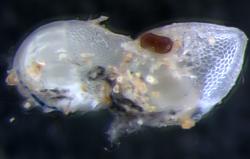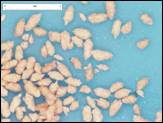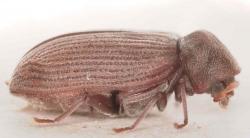Adult
Size
2 to 5 mm long
Aspect
Elongate, more or less cylindrical.
Head and base of antennae entirely covered by the pronotum (prothorax) and therefore not visible from above.
The pronotum has a fine grain-like aspect, it is not quite as wide as the elytra at their base (identification criterion), it has a sharp triangular median protuberance on top.
The slightly grainy elytra are striated and punctuated by big, deep dots in regular lines. They are covered by a fine yellowish pubescence that is curved backward.
Clubbed antennae, clubs formed of three rather elongate articles.
Colour
Reddish brown to chocolate brown


 Petite Vrillette; Vrillette commune; Vrillette domestique; Cosson; Ver du bois; Ver des meubles.
Petite Vrillette; Vrillette commune; Vrillette domestique; Cosson; Ver du bois; Ver des meubles.  Common furniture beetle
Common furniture beetle  Carcoma comun de los muebles
Carcoma comun de los muebles  Gemeine nagekäfer
Gemeine nagekäfer 



